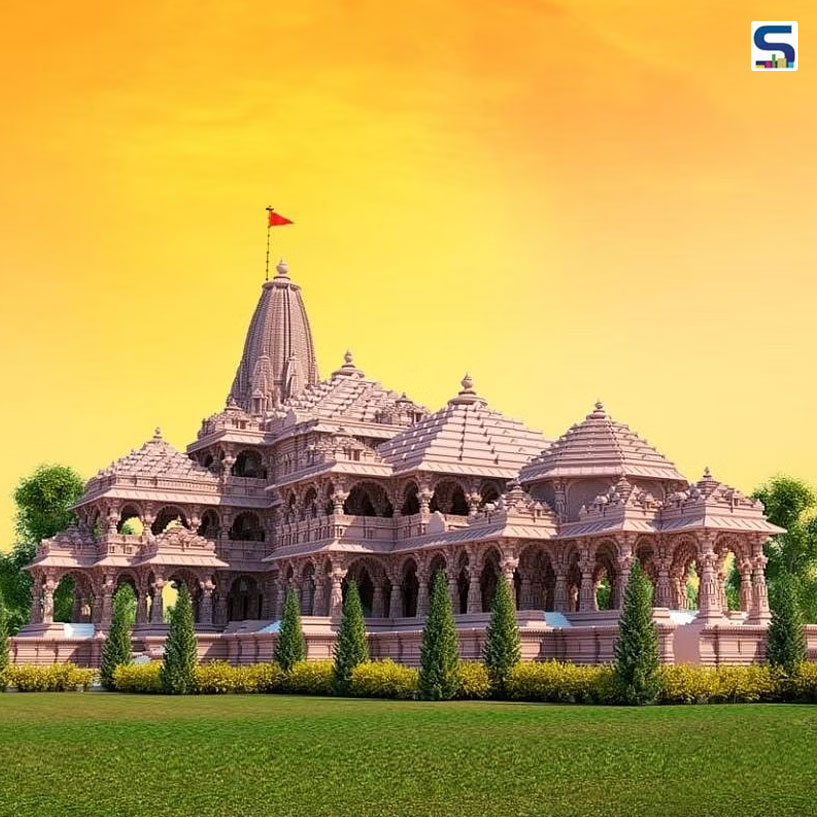
The design of the Ram Mandir in Ayodhya is influenced by both North and South Indian temple architecture, creating a pan-Indian appeal. According to Girish Sahastrabhojini, the temple's design and construction manager, the Nagara style from the north is complemented by elements from renowned South Indian shrines like Rameshwaram, Tirupati, and Kanchipuram. SURFACES REPORTER (SR) will provide an in-depth insights on the Ayodhya temple's architecture in this article. Read on:
Rising to an impressive height of 161 feet with three floors, the earthquake-resistant Ayodhya Ram temple is carefully built following Vastushastra and Shilpishastra principles, using stones from the Banshi mountains in Rajasthan. Within the project, five mandapas serve distinct purposes between the garbhagriha and entrance, creating a total of 360 pillars that enhance the overall structure.
The fusion of different Indian architectural styles is evident in the Ram Temple, designed by Ar Chandrakant Sompura who has designed 200 temples in the Nagara style, including renowned ones like Akshardham and Somnath temples in Gujarat. Predominantly following the Nagar style prominent in northern India, characterized by tall, pyramid-like towers known as shikharas, the temple also incorporates elements of Dravidian architecture. This influence is notably apparent in the smaller temples within the complex and extends to the outer wall. The main temple will be surrounded by a 40-ft wide, two-leveled 'parakota' or wall, representing a distinctive feature of the Dravidian style of architecture.
Materials from Across India Used in Construction
The construction of the Ram Temple in Ayodhya involved the sourcing of materials from various regions of India.
Granite, sourced from Telangana and Karnataka, was used in construction, while flooring material came from Madhya Pradesh, and the stone of superstructure from Rajasthan.
Skilled sculptors from Odisha contributed intricate sandstone carvings, creating a harmonious blend of materials from different parts of the country.
Diverse Workforce and Expertise
The diverse workforce and expertise behind the construction further highlight the pan-Indian collaboration. Woodwork was entrusted to a company based in Andhra Pradesh, employing workers from Tamil Nadu. Brassware was sourced from Uttar Pradesh, and goldwork from Maharashtra.
Construction Challenges and Innovative Solutions
Larsen and Toubro, the construction major, engaged around 4,000 workers, including local stone carvers and craftsmen from Rajasthan and Mysuru.
The challenges of the construction process included the historical proximity of the Saryu river, leading to loose and weak soil. The team addressed this by replacing the soil with an engineering fill using lean concrete.
No Use of Steel or Concrete
Notably, the construction of the Ram Temple refrained from using steel and concrete in the temple designn. Sahastrabhojini emphasized that only materials with a track record of centuries were used in the construction, ensuring the temple's longevity.
Modern materials like carbon fibre, glass rod, and composites were avoided, relying on proven materials such as rock, which has a historical track record.
Nagara Style Overview
The Nagara style of temple architecture, with roots dating back to the 5th century AD, has significantly influenced temple designs across India. Its impact spans from Northern India to Karnataka, including regions in Madhya Pradesh, Odisha, and Gujarat, making it widely significant throughout the country.
This architectural style did not confine itself to a specific time period; it flourished during the Gupta dynasty and continued evolving through different regional kingdoms and empires in northern India. Recognized for its tower-like structures, called 'shikhara' or spires, Nagara style symbolizes Mount Meru – a sacred mountain in Hindu, Jain, and Buddhist cosmology, representing various dimensions.
In contrast to southern India, Nagara temples typically lack elaborate boundary walls or gateways, and their circumambulatory path ('pradakshina patha') is covered. Temples in this style are often constructed on an elevated platform ('jagati'), with mandapas situated in front of the Garbhagriha. The temple's layout follows a specific pattern, reflecting the cosmic order and the journey of the soul towards liberation.
Key Elements of Nagara Style
The Nagara style of temple architecture encompasses key elements that embody profound spiritual symbolism. Central to this style is the Vastu Purusha Mandala, a sacred cosmic diagram shaping the temple's plan for alignment with cosmic energies. The Garbhagriha, the sanctum sanctorum, symbolizes the womb of creation, carefully housing the deity to maintain cosmic harmony. A circumambulatory path, the Pradakshina Patha, allows devotees to walk around the garbhagriha, expressing respect and devotion. The tall Vimana is like Mount Meru, showing the soul's journey to heaven. The open Mandapa is a shared space with sculptures for a spiritual experience. The Antarala represents moving from material to divine, and the ornate Ardhamandapa is a doorway to the sacred inside. Smaller shrines around the temple honor other deities, making the whole complex visually attractive.
Nagara architecture is a style used across India, but each region adds its own twist.In Odisha, temples have intricate stone carvings and towering spires, like in Bhubaneswar, Puri, and Konark. Gujarat keeps it elegant and simple, as seen in the Sun Temple in Modhera and Somnath Temple, focusing on overall harmony and beautiful sculptures. Rajasthan's style has Rajput influences with detailed marble carvings in places like the Dilwara Temples and Sun Temple of Ranakpur. Karnataka in the South has simpler towers, emphasizing pillar carvings, like in the Virupaksha Temple and Lepakshi Veerabhadra Temple. In Central India, temples, like those in Khajuraho, have stepped spires and diverse sculptures.
Nagara architecture, embodying spirituality and beauty, stands as a fundamental aspect of India's cultural heritage. Even in contemporary times, structures like the Ram temple draw inspiration from this legacy, aiming to evoke the same sense of wonder as ancient Indian temples. Further, SURFACES REPORTER (SR) believes that beyond its religious implications, the construction of the Ram Mandir in Ayodhya is anticipated to stimulate the local economy, create employment opportunities, and attract tourism.The ongoing construction has already provided job opportunities for workers like stone carvers and craftsmen. Additionally, the project is likely to increase the demand for hotels, restaurants, and local transportation, with 89 companies expressing interest in building hotels in Ayodhya, indicating substantial economic development.